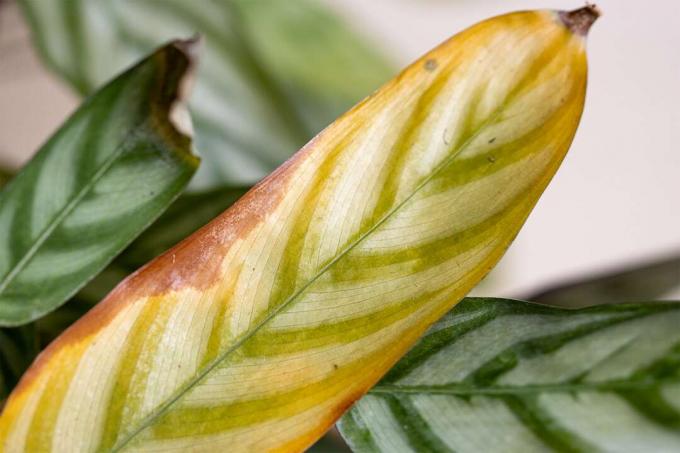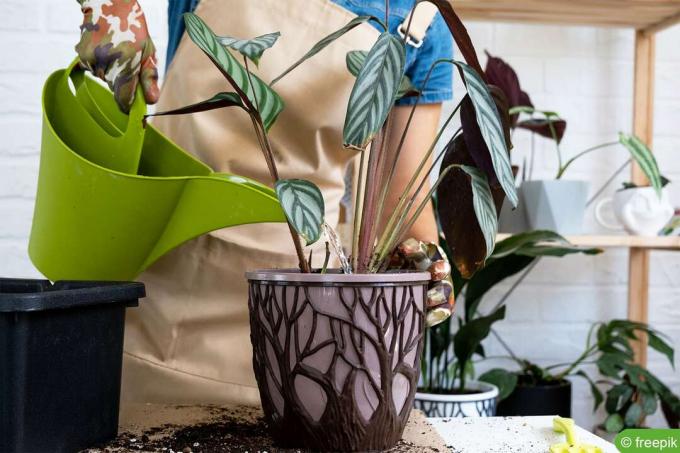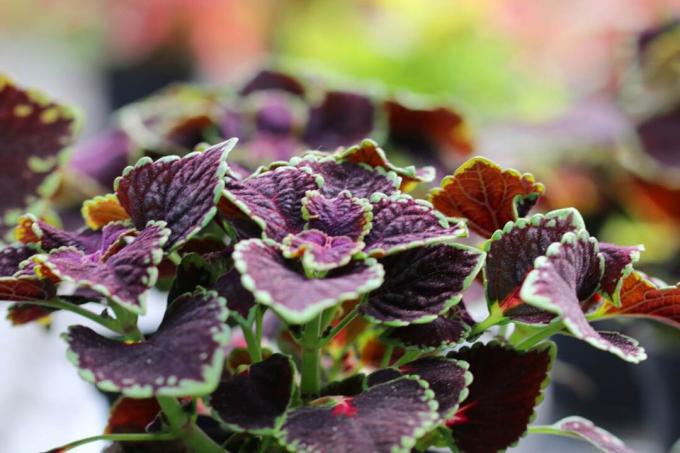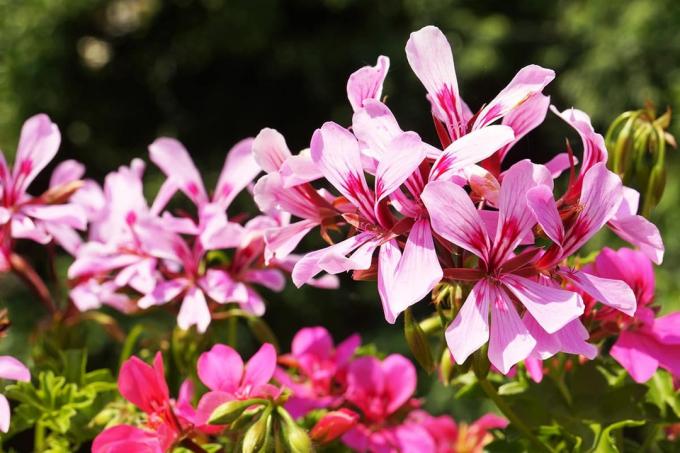

Table of contents
- causes
- rescue measures
- site check
- nursing exam
- irrigation
- fertilizer problems
- pests
- frequently asked Questions
When a Coriander (Calathea) gets yellow leaves, the cause is usually a lack of care. In order to save them from dying, a number of countermeasures must be taken, which are described in detail here.
causes
The causes of yellow leaves are usually due to human error, which mainly affects care and the right site conditions, but also pest infestations:
- wrong watering
- too low humidity
- bad lighting conditions
- temperature fluctuations
- too much fertilizer
- pests
rescue measures
Because the cause is not always clearly identifiable, when rescuing a calathea all possible factors are taken into account, checked and corrected according to the plant requirements become.

site check
The ideal location is vital for Korbmaranten. Yellow leaves are often due to suboptimal conditions at the location, which is why these must be checked first and changes made if necessary:
- direct sunlight: Place the plant at least 1 meter away from the window, avoid south-facing windows, protect with curtains, roller blinds, awnings, blinds
- insufficiently high humidity: Set up an air humidifier or water bowl next to the plant and protect it from dry heating air
- Temperature fluctuations: Avoid draughts, protect plants near window openings
- too low temperature: offer at least 16 degrees Celsius ambient temperature; do not shower with cold water
nursing exam
The calathea is considered a very robust and easy-care plant. However, it reacts with yellow leaves if its owners mean well and/or make mistakes in care. In order to save a yellow-leaved osiera, you should check the following care attributes to help the plant recover. In some cases, targeted countermeasures are required:
irrigation
The calathea needs a slightly moist soil at all times, without being completely soaked, because this leads to yellow leaves, just like soil that is too dry.

If the surface of the earth can be dented easily or is even muddy, it has too much water. She should pot them up and free them from the wet earth. Then it should be placed in fresh, dry substrate and only slightly watered again after a few days.
If the surface of the soil can be pressed in less than two centimeters with a finger, the soil is dry. The longer this condition has existed, the more important it is that it gets plenty of water quickly. The best way to do this is to unpot the plant and soak the roots in a bucket of water until there are no more air bubbles. Then it should be placed in a fresh, loose substrate and ideally watered less frequently, but more vigorously.
Tip:
Use rainwater for watering, because tap water contains minerals such as magnesium, which can settle on the ground and affect the absorption capacity of the roots.
fertilizer problems
The calathea prefers a slightly acidic soil environment has a pH of about 6.5. If you fertilize too often or with the wrong fertilizer, so that the soil becomes too acidic, the leaves of the calathea will yellow quickly. If too much fertilizer has been used, the plant can usually only be saved by removing it from the over-fertilized soil removed, carefully washed the roots and placed back in fresh, nutrient-rich substrate is planted. In the future, liquid fertilizer should be applied no more than once a month during the growing season. Fertilization should be stopped from late summer or early autumn.
pests
If there is a disease or a pest infestation, this can be recognized fairly precisely and allows targeted control measures.

Yellow leaves on a calathea are caused in over 90 percent of all cases by voracious spider mites, which suck nutrients from the leaves. The tiny, one millimeter small parasites can be seen on the undersides of the leaves. They owe their name to the sticky, white webs that they stretch over the leaves and stems. Fast action is required here in order to be able to save the plant. This works best with a canola oil treatment, prepared and used as follows:
- Mix 1 part canola oil and 4 parts water
- add a few squirts of dish soap (to build tension and hold the liquid on leaves and parasites)
- Fill the mixture into a spray container and spray the plant until dripping wet, especially the undersides of the leaves
- repeat every other day for a week
- Cut off damaged, yellow leaves
- Finally, give the plant a lukewarm shower to avoid sticking from dish soap and rapeseed oil
A notice:
Also Mealybug, fungus gnats as well as aphids and scale insects are possible "culprits" for yellow leaves. These are also easy to fight with the rapeseed oil mixture because it clogs the airways of the parasites and causes death by asphyxiation.
frequently asked Questions
Yellow leaves are always a plant response to a risky cause. Cutting it off does not remedy this and yellow leaves continue to form, which can lead to the calathea dying off.
Yellow leaves are usually caused by a lack of supply. Sooner or later, this also includes the water supply for the leaves, which is why they then turn brown and dry up. Sometimes they fall off before then.
 Maike
Maike
Learn more about houseplants

Room bamboo: 13 tips for care
The room bamboo impresses with its compact growth habit and is a densely grown houseplant. The ten most important tips for caring for the sweet grass are compiled for you here.

Coleus blumei: 21 tips for the red nettle
The colored nettle is a warmth-loving and easy-care foliage plant. The coloring of the leaves varies from monochromatic to variegated with a wide variety of drawings. Spectacular splashes of color can be set in beds, balcony boxes and tubs or as a houseplant.

Scented houseplants: 25 scented plants for the home
An apartment without indoor plants is hardly conceivable. Scented plants in particular have a very special effect. Not only are they decorative, they can lighten the mood and rival any artificial home fragrance.

Lucky chestnut, Pachira aquatica: care from A to Z
The care of the lucky chestnut does not require any special expertise. However, if you know the way of life of this ornamental plant, you can better adapt site conditions and care measures to your needs. The plant can be easily propagated if a plant already exists.

Rubber tree: 13 care tips for Ficus elastica
The rubber tree is one of the most popular indoor plants. It is available in different varieties, easy to care for and stands out for its large leaves, which are colored in intense shades of green. Within a few years, it grows into a state small tree without much effort.

Ray Aralia, Schefflera: care from A to Z
Schefflera arboricola delights hobby gardeners with lush growth in suitable locations. It has hardly any special requirements and proves to be extremely easy to care for. Beginners will have a lot of fun with this plant because it forgives minor care mistakes and is adaptable.



